Investigating the impact of multi-rotor structure shadowing on tidal stream turbine performance
By Bryn Townley, Professor Qing Xiao
This research focuses on the wake-induced effects these modular multi-rotor foundations have on turbine performance. Understanding these impacts is vital for accurately estimating energy yield, mechanical loading, and the fatigue life of the turbines. Our studies initiate with the HydroWing multi-rotor device concept, investigating the relationship between the turbulent wake from a modular ballast-weighted foundation and a 2-bladed Horizontal Axis Tidal Turbine (HATT).
We employ a transient RANS Computational Fluid Dynamics (CFD) simulation environment with a sliding mesh, validated against experimental data. Initial simulations compare a turbine in free-stream isolation with scenarios including the modular foundation, analyzing structural impacts on performance. Preliminary results indicate potential fluctuations in thrust loading of approximately 20% at a frequency of 1.82 Hz, corresponding to an average reduction of about 8% in coefficient of power (CP) over a revolution.
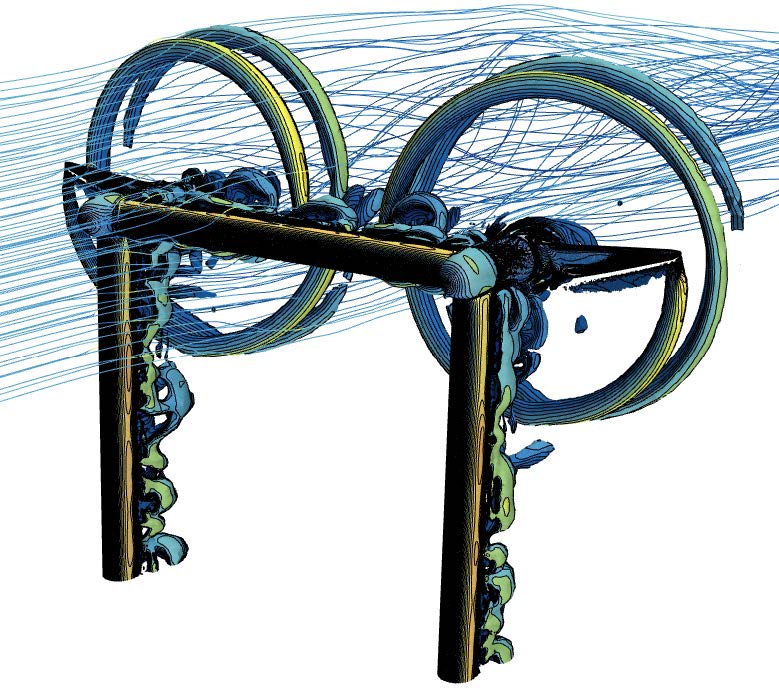
A CFD analysis on the fluid-structure interaction of floating offshore wind turbines
By Xiang Li, Professor Qing Xiao
This project explores the performance of a fully coupled wind turbine array in the presence of waves by coupling the Actuator Line Model (ALM). This significantly reduces the time cost and complexity compared to the blade resolved method, making the simulation of FOWT farm simulation possible.
The three FOWTs with different staggered layouts are simulated, their dynamic response and wake interactions are analyzed. The results indicate that the periodic motion caused by waves introduces an oscillation in the power output and thrust. It is also found that the pitch and surge motion have opposite influence on the power output.

Numerical analysis of the flexible OWC WEC with structured sheet materials
By Yang Huang, Professor Qing Xiao
To enhance the power output of flexible wave energy converters (WECs) while avoiding the risk of failure due to excessive structural deformation, structured sheet materials have drawn our attention. These are flexible materials with a sandwich structure, where the middle layer contains hollow shapes made of flexible materials. Different patterns confer different properties to the material. Therefore, by choosing an appropriate pattern, structured sheet materials can exhibit lower stiffness under low pressure and higher stiffness under high pressure. This dual behavior allows for significant deformation under low pressure, increasing the power output of flexible WECs, while also reducing structural deformation under extreme conditions, thereby enhancing device safety.
In this project, we utilize a fluid-structure interaction (FSI) analysis tool based on a combined computational fluid dynamics (CFD) and finite element analysis (FEA) approach to simulate the flexible oscillating water column (OWC) WEC using structured sheet materials. The performance of the device, including the deformation of the flexible membrane, stress distribution, flow field, and power output, are fully explored and compared with those of the WEC using a conventional sheet of natural rubber material. The results show a significant increase in the power output of the OWC WEC, with only a slight increase in stress within the flexible membrane.

Bio-Inspired blades: A fully coupled FSI-CFD investigation on the effect of blade’s trailing edge flexibility on the performance of a Vertical Axis Wind Turbine
By Satyam Shukla, Professor Qing Xiao
In the quest for sustainable energy solutions, the demand for clean and environmentally friendly alternatives has reached unprecedented levels. Wind energy emerges as a promising avenue, offering renewable power without the detrimental environmental effects associated with fossil fuels. Nevertheless, the efficiency of Vertical Axis Wind Turbines (VAWTs) has often fallen short of expectations when compared to Horizontal Axis Wind Turbines (HAWTs), prompting a concerted effort to explore innovative optimization strategies.
Drawing inspiration from nature’s remarkable efficiency, researchers have redirected their focus towards aquatic animals, renowned for their streamlined and agile movement within fluid environments. Conducting experiments to analyze these bio-inspired approaches can be prohibitively expensive, leading to an exploration of Computational Fluid Dynamics (CFD) as a cost-effective means of investigation.
This novel approach represents a departure from conventional fixed-blade designs by introducing flexibility into the turbine’s blade trailing edge. By emulating the dynamic response of aquatic creatures to fluid forces, the objective is to enhance turbine efficiency and overall performance. Through coupled CFD and FSI simulations, the effect of trailing edge flexibility on the blade aerodynamic forces thus the turbine performance will be comprehensively examined.
FSI analysis of a flexible device under VIV/Galloping induced by low velocity water flow
By Estefan Leopoldo Diaz Mercado, Professor Qing Xiao
This project focused on the development of a device comprised of a deformable cantilever beam attached to a bluff body in a uniform water flow. The beam is to be constructed of a nano generative material capable of harvesting the fluid motions produced by the interaction of flow with bluff body thereby prompting vortex induced vibrations (VIV) and galloping.
Research for this is carried out with commercial computational fluid dynamics (CFD) software in tandem with a finite element analysis (FEA) solver to gather fluid structure interaction (FSI) data that is to be utilised for the design and validation of prototype testing in Kelvin Hydrodynamics Laboratory (KHL). In addition to FSI, numerical analysis for estimating power generation based on parameters such as stiffness, damping, frequency, and mass ratio is imperative toward the design of a successful experiment of this renewable energy device. The results of this research could point toward optimum design parameters such as bluff body shape and aid in understanding how to utilize a low velocity water flow for clean energy production.
Experimental study on the flexible tube WEC
By Yang Huang, Professor Qing Xiao
To further enhance our understanding of the resonant response of the flexible tube wave energy converter (WEC) in waves, a series of wave tank tests were conducted for a 3.52m long tube at the Kelvin Hydrodynamics Laboratory of the University of Strathclyde. An orifice plate was mounted on top of the right vertical tube to simulate the actual Power Take-Off (PTO) of the device. A mooring line was tied to the bow of the tube to limit the heave motion of the device. Various wave frequencies and amplitudes were tested on the flexible tube WEC. The variations in wave elevation in the Oscillating Water Column (OWC), pressure at the holes of the orifice plate, and tube deformation were measured to detect the responses of the device.
The results revealed several resonant responses, including those occurring when the bulge wave speed matches the incident water wave speed, the natural frequency of the OWC, and the natural frequency of the bow’s heave motion. Additionally, the impact of PTO impedance, pre-stretching, and wave amplitude on the FSI responses of the flexible tube WEC was investigated and discussed.
The dynamic response of floating offshore wind turbine platform in wave-current condition
By Xiang Li, Professor Qing Xiao
In this project, the fluid-structure interaction (FSI) of floating offshore wind turbine (FOWT) platforms under complex ocean conditions is investigated. OpenFOAM and in-house developed models are utilized. Two types of FOWT platform, i.e., a semi-submersible platform and a barge platform, are studied for their dynamic responses to either wave or current.
Results reveal that a semi-submersible platform exhibits larger cross-flow motion and lock-in phenomenon, while a barge platform experiences smaller motion with no significant lock-in within the velocity range examined. Unlike other investigations focusing on colinear wave-current interaction, in which the waves usually mitigate vortex-induced-motion (VIM), here, we find that waves might lead to an enhanced VIM with a large angle between current and wave. The evaluation on the interaction effect factor (IEF) shows that even a smaller wave height with large wave period can induce even larger motion.

A high-fidelity study on the flexible tube WEC using CFD-FEA method
By Yang Huang, Professor Qing Xiao
To obtain a deeper understanding of the dynamic response of the flexible tube wave energy converter (WEC) in a realistic ocean environment, a coupled numerical analysis tool based on computational fluid dynamics (CFD) and finite element analysis (FEA) methods was established. This tool performs fluid-structure interaction (FSI) simulations for a typical flexible tube WEC, known as Anaconda. The surrounding flow is solved using a two-phase CFD solver, and the structural dynamics are calculated with a three-dimensional (3D) FEA code. Strong coupling between the fluid and solid phases is achieved through the adoption of a multi-physical coupling library.
With this tool, the FSI responses of the Anaconda WEC with mooring lines under regular waves can be captured. The motion of the tube, pressure field, generated power, structure deformation, and stress distribution are fully examined to explore the complex dynamic responses of the device. The influence of the mooring line on the performance of the Anaconda WEC is also investigated. The results indicate that an increase in mooring line stiffness leads to a reduction in the tube’s bow motion, resulting in decreased internal pressure and reduced energy generation. Furthermore, a higher mooring line stiffness reduces the extent of variation in the cross-sectional area, leading to lower hoop stress and mitigating the risk of material failure.
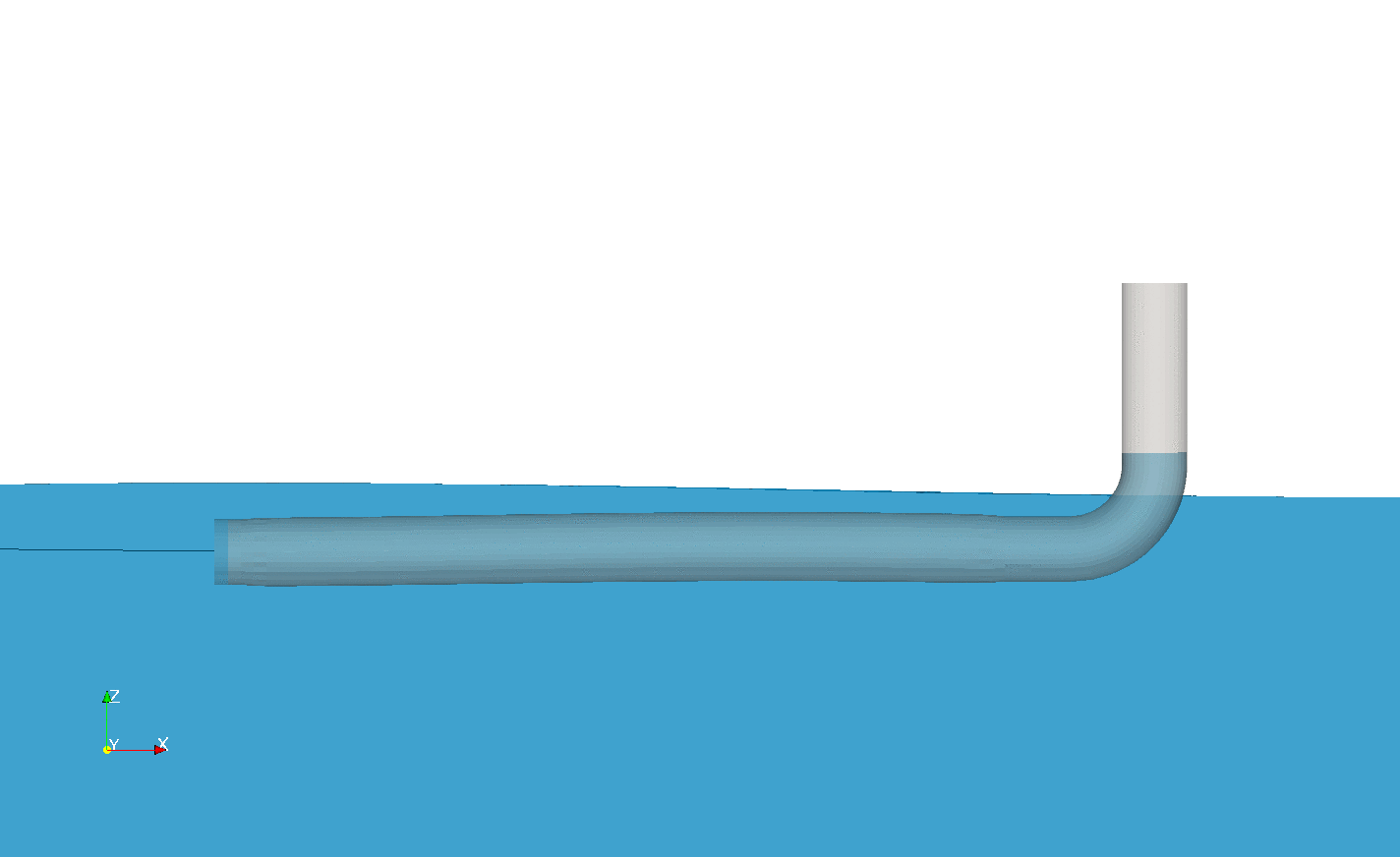
A fluid-structure interaction study on flexible wave energy converter
By Xiang Li, Professor Qing Xiao
In this project, a novel flexible wave energy converter (fWEC), is numerically modelled in this paper. The fWEC is believed to be more efficient and has a greater range of operation when compared to the conventionally rigid WEC. A fully coupled fluid-structure interaction (FSI) tool is developed for the research. This tool is able to accommodate the dynamic interaction between the flexible membrane structure of the fWEC and the surrounding fluid.
In this research, both linear-elastic and hyper-elastic mate-rials are examined for their use in the fWEC. The fluid flow surrounding the fWEC is solved by a computational fluid dynamics (CFD) method. The deformation of the hyper-elastic structure within the fWEC is modelled using a finite element analysis method (FEA). Both the hyper-elastic material of the fWEC and the free-surface wave contribute to the overall non-linearity of the numerical simulation. To tackle this problem, a robust coupling scheme is implemented by an advanced coupling library. With this tool, the flexible deformations within the fWEC structure can be accurately captured.
Digital Twin model of Floating offshore wind turbine with fully coupled aero-hydrodynamic simulation
By Hoi Yin Yung, Professor Qing Xiao
The project aims for building a Digital Twin model with a 3D fully coupled Aero-hydrodynamic FOWT CFD model and using this tool to predict the life and performance of a real construction considering the Fluid-Structural Interaction.
The proposed framework will specifically address fundamental and practical challenges in area of the hydro-structural response of a FOWT. The insight to be gained can provide the offshore wind industry with an enhanced analysis tool to better predict the hydrodynamic loading, motion response of under-water sub-structures of FOWT under extreme wave conditions, and an indication of the errors which may be expected from the use of simpler linearized tools in extreme conditions.
CFD analysis of the Flexible Wave Energy Converter Using Bionic Adaptive Stretchable Material
By Dr Yang Huang, Professor Qing Xiao
Wave Energy Converters (WECs) transform the kinetic and/or potential energy of ocean waves into electricity. Among different types of WECs technologies, none of them achieves economic competitiveness. The main challenges of commercialisation of existing WECs arise from the devices’ low-performance efficiency and the WEC system’s vulnerability under harsh sea conditions. Inspired by aquatic animals’ flexible body and fins, a range of adaptive, flexible materials have attracted attention in WEC development in the past decade. The specific characteristic of such material is that its shape deforms adapting to the loading applied to it. There are several benefits using a flexible material as part of WEC structures.
To achieve the main objectives, the research will develop a hydro-elastic analysis tool based on advanced Computational Fluid Dynamics techniques to provide a robust analysis method for prescribing the detailed materials specification required by the desired WEC functionalities and allow the benchmarking of the lower-order rapid models developed in parallel for device optimization. The complex physics and effect of flexible material will be crosschecked by simulation method and laboratory testing at the small-scale device level, providing new insight. Knowledge of complex coupled hydro-elastic models will be beneficial to general offshore renewable energy.
The latest progress regarding the numerical simulation part of the BASM-WEC project can be found here.

Fluid-Structure Interaction (FSI) Analysis of the Composite Material Blades
By Zhongsheng Deng, Professor Qing Xiao
The mechanical properties of composite materials blades in terms of, for example, stiffness and tensile, behaves vastly different compared to the conventional metal-based blades. In order to investigate the impacts when the wind flows functioning on the blades, a fully-coupled CFD and composite material FSI numerical model will be analysed with the use of both commercial CFD software and our in-house code.
The main objective is to understand the mechanics of wind turbine blades change under various unsteady wind environments for the offshore bottom fixed and floating wind turbine.
By conducting this research, the information provided from numerical modelling will contribute to the structural fatigue analysis and blade design optimization
CFD investigation of FWOT performance under extreme wave conditions
By Xiang Li, Professor Qing Xiao
As a renewable and clean energy source, the usage of wind energy has shown an upward trend in recent years. The Floating Offshore Wind Turbines (FOWT) has won high importance due to the increased demand on the renewable energy. However, we are still facing challenges in the motion predictions of FOWT under extreme conditions, high wind speed or/and high wave amplitudes etc. Therefore, a fully coupled numerical tool that is able to accurately predict and analyse the motions and responses of the complicated FOWT system is increasingly needed.
In present study, we are developing such a numerical tool based on OpenFOAM, which is an open source CFD package and can be extended easily. This numerical tool has been developed and applied to various problems in the past few years and the results have been published as journal articles which can be downloaded on our group website. In present numerical methods, both the aerodynamics and the hydrodynamics are resolved by solving the incompressible Navier-Stokes equations including different turbulence models, and the Volume of Fluid (VOF) method is used to capture the free surface. Besides, a wave generation module is incorporated in present code which is able to model various types of waves. Considering the effect of mooring system on the performance of FOWT, a quasi-static mooring line analysis model is integrated in current numerical tool. As for the mesh motion, the arbitrary mesh interface (AMI) mesh technique in OpenFOAM is applied to deal with the rotating machinery problems. The surge, heave and pitch motions are applied to the whole computational domain.
My work focuses on further extending our existing code by introducing the control strategies. By setting up a specific state space model and using certain judge theorem and rules, we will testify the stability and controllability and investigate how the control system works under different working conditions, especially under extreme conditions.
Analysis of FOWT Performance under Extreme Load Conditions and Control Strategy
By Yang Zhou, Professor Qing Xiao
Because of worries about energy crisis in recent years, it is imperative to find a cleaner and more efficient way to produce energy, to satisfy the world’s growing appetite for energy. As a clean way to harvest energy, wind turbines became a good option. In the past, they were mostly deployed on land, far away from the city centre. Compared with onshore turbines, offshore turbines have the advantage of being located close to the population centres, which makes it more attractive. When the water becomes deeper when moving forward to the ocean, fixing a wind turbine on the seabed in deep water is so expensive that it is impossible to put them on the market. That the purpose of developing floating offshore wind turbines (FOWT) which can be installed to any depth.
The research will focus on the influence and damage of the complex situation on the floating structure, with current, wave, and wind combined. In consideration of the complex situation in deep waters and the impossibility for a wind turbine to move to a safe location, aerodynamics, hydrodynamics and structural dynamics of a FOWT under extreme sea conditions are extraordinarily important. Therefore, more attention will be paid to study and analyse the ability for a FOWT to survive. At this phase, a CFD tool combined with an open-source multibody software is developed to simulate the mechanic links between different parts of structures.
A CFD investigation of the hydrodynamic response of focused wave impact on a floating platform for floating offshore wind turbine
By Yang Zhou, Professor Qing Xiao
The recent study has been focused on the hydrodynamic responses of the OC4 DeepCwind semi-submersible platform under focused waves(presented in OMAE2019, paper number OMAE2019-96043). The dynamic responses of the platform are numerically simulated under various focused wave parameters. Compared to regular waves, the occurrence of wave overtopping and the rather large wave run-up at starboard column is the significant difference between two types of waves.
The results are compared with those obtained from an in-house potential flow theory tool at Électricité de France (EDF). It is found that the predicted CFD surge motion responses are close to those achieved with the second order potential theory while differ from the results obtained using linear potential theory. As to the pitch motion, differences are observed between two results, mainly to the different methods used for high order loads and viscous effects calculation. The strong nonlinearity of the entire FOWT system at large waves will be the interests of our near future studies.
Analysis of FOWT Performance under Extreme Load Conditions and Control Strategy
By Yang Zhou, Professor Qing Xiao
As a renewable and clean energy source, the usage of wind energy has shown an upward trend in recent years. The Floating Offshore Wind Turbines (FOWT) has won high importance due to the increased demand on the renewable energy. However, we are still facing challenges in the motion predictions of FOWT under extreme conditions, high wind speed or/and high wave amplitudes etc. Therefore, a fully coupled numerical tool that is able to accurately predict and analyse the motions and responses of the complicated FOWT system is increasingly needed.
In present study, we are developing such a numerical tool based on OpenFOAM, which is an open source CFD package and can be extended easily. This numerical tool has been developed and applied to various problems in the past few years and the results have been published as journal articles which can be downloaded on our group website. In present numerical methods, both the aerodynamics and the hydrodynamics are resolved by solving the incompressible Navier-Stokes equations including different turbulence models, and the Volume of Fluid (VOF) method is used to capture the free surface. Besides, a wave generation module is incorporated in present code which is able to model various types of waves. Considering the effect of mooring system on the performance of FOWT, a quasi-static mooring line analysis model is integrated in current numerical tool. As for the mesh motion, the arbitrary mesh interface (AMI) mesh technique in OpenFOAM is applied to deal with the rotating machinery problems. The surge, heave and pitch motions are applied to the whole computational domain.
My work focuses on further extending our existing code by introducing the control strategies. By setting up a specific state space model and using certain judge theorem and rules, we will testify the stability and controllability and investigate how the control system works under different working conditions, especially under extreme conditions.
Numerical Simulations of Fluid-Structure Interaction Problems Based on Overset Grid Technique
By Guangyu Shi, Professor Qing Xiao
The project is to develop an overset-based partitioned Fluid-Structure Interaction (FSI) solver with applications to aero-elastic problems, such as flapping wing dynamics, wing flutter predictions and renewable energy devices.
The solver involves many different modules, e.g., flow solver, structural solver, mesh deformation solver, overset grid assembler and interfaces between fluid and solid. The fluid dynamics is resolved by solving the compressible unsteady Navier-Stokes equations with different turbulent models. In structural part, two different solvers are available, namely, modal analysis method and non-linear Euler-Bernoulli beam model. Both structural solvers are coupled with the flow solver in a partitioned framework. The Implicit Hole Cutting (IHC) method is used in present overset grid assembler, which is easier to implement and has more efficiency. The overset grid technique is also expected to alleviate the effort and complexity when generating meshes. Two options are provided to transfer data between fluid domain and solid domain, which are the inverse Boundary Element Method (BEM) and the Constant Volume Tetrahedron (CVT) method.
Present FSI solver has the capability to simulate many different FSI problems in engineering. For example, the prediction of wing flutter boundary in aeronautical engineering, the dynamics of flapping wings in biomimetic engineering and the Vortex Induced Vibrations (VIV) of long and flexible risers in offshore engineering.
Analysis of FOWT Performance under Extreme Load Conditions and Control Strategy
By Mitchell Borg, Professor Qing Xiao
In consequence to the development of global warming, clean-energy generation, together with more sustainable engineering practices, are required to diminish the damage ensued to our environment. To decrease grid dependency on fossil fuels, recent practices in the offshore renewable energy industry have exploited hydropower sources in an effort to generate energy from the motion of tidal currents by means of subsea turbines.
This thesis presents a numerical analysis to investigate the fluid dynamics and structural mechanics of a subsea open-centred tidal turbine with use of the popular computational fluid dynamics (CFD) software ANSYS Fluent. Primarily, a rigid multi-bladed turbine will be modelled to establish the hydrodynamic parameters of the system, and validate the numerical model with experimentation results found in literature.
Subsequently, a flexible multi-bladed turbine will be fabricated from composite materials, where experimental analysis will be undertaken to specify its unique hydrodynamic parameters. A numerical model will then be developed to replicate and analyse the fluid-structure interaction of the non-rigid turbine by means of coupled CFD and FEA software. The numerical and experimental analyses will then be associated to establish a validated CFD-FSI model for a turbine setup. Furthermore, a full turbine farm will be set up by means of a coupled CFD-AD method, where physical actuator disk theory will be applied within the model to establish the turbulent parameters of the hydrodynamic flow along the farm. By this means, an appropriate turbine configuration may be deduced.
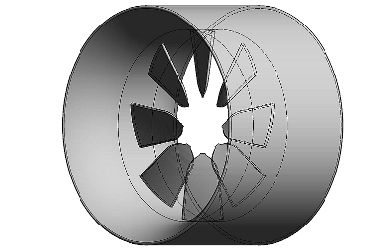
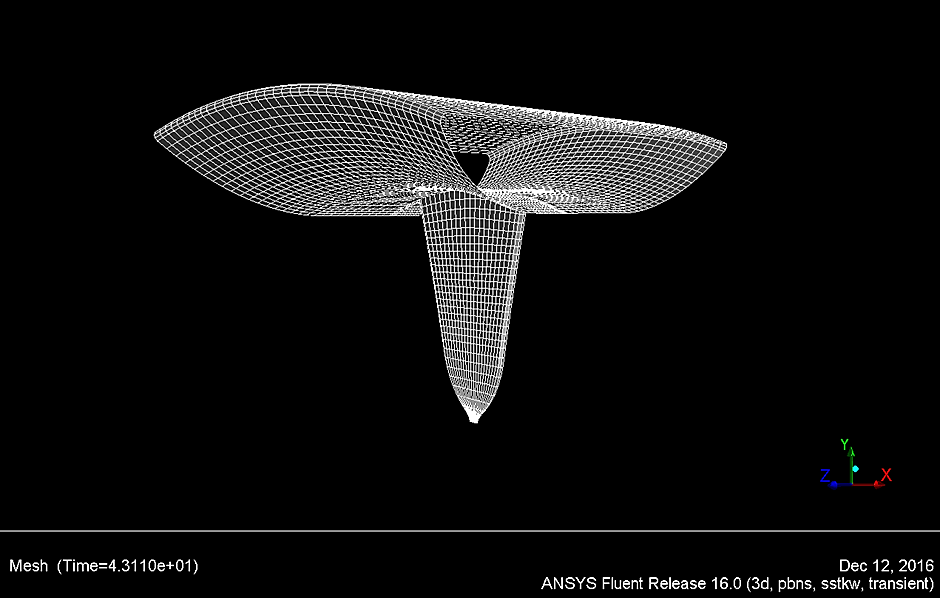
Fluid Structure Interaction Analysis of Renewable Turbine
By Guangyu Shi, Professor Qing Xiao
Fossil fuels are not renewable, and also cause environmental problems such as global warming, air pollution and so on. Thus, renewable and eco-friendly energy is of great importance for our human. Tidal current energy is one of the sustainable energies. It is predictable and renewable. However, we meet many problems when we exploit this kind of energy, such as conversion efficiency, structural fatigue and other Fluid-Structure Interaction (FSI) problems.
One way to solve these problems is to study renewable turbines by numerical simulations. Computational Fluid Dynamics (CFD) and Finite Element Analysis provide very useful tools for us to study these problems. The key challenge to solve these problems is developing an effective means to solve each individual physical field accurately and then couple/integrate fluid and structural fields in a proper way. Our research here needs to further develop the in-house CFD and FEA codes as well as commercial software (Fluent, CFX etc.) to study the basic FSI mechanism involved in turbine machine. The main tasks to further develop the FSI solver may include but not limited to enhance the functionality of the existing transient solver to be able to deal with a wide range of moving boundary and FSI problems, develop an effective mesh motion function (such as overset grids) so as to a large structural deformation problem could be solved. The expected outcomes are the improvement of renewable turbine’s conversion efficiency. But CFD and FEA are computational consuming. It usually takes hundreds of CPUs to work thousands of hours
The following video shows the instantaneous deformation of a flexible flapping membrane as well as the periodical vortex shedding.
Investigation on Darrieus Type Straight Blade Vertical Axis Wind Turbine with Flexible Blade
By Wendi Liu, Professor Qing Xiao
In this study, a three-dimensional VAWT with a spanwise passively deformable flexible blade has been modelled. The study mainly focuses on the analysis of blade structure characteristics associated with the bending and twist deflection. Two types of flexible blade material and two strut locations supporting H-type blades are being investigated. The unsteady external loads and energy efficiency of VAWT with such designed flexible blade are also being analysed. The simulation results show that the bending and twist deflection peak is positively correlated with the turbine tip speed ratio. For a flexible blade, an unevenly distributed structural stress along the blade with a high stress regime in the vicinity of strut location has also been observed. Due to the rotational motion of a VAWT, the centrifugal force acting on VAWT blade plays an important role on the blade structure characteristics. Reduction of the blade stiffness results in an increase of the blade stress. Changing the strut location from middle to tip will cause a large area under high stress. The results also indicate that the VAWT with a highly flexible blade is not an efficient energy extraction device when it is compared to a less flexible or a rigid blade.
A Study on Oscillating Foil Energy Harvester with a Passive Flexible Foil
By Wendi Liu, Professor Qing Xiao and Supported by Lloyd’s Register Group Limited
The present research is an extension of our previous work, which indicated that a flexible foil has a positive contribution to the energy extraction enhancement with an oscillating foil energy device. Other than an active controlled foil bending in Liu et al 2013, by prescribing the deformation of foil, the current research investigates the passive motion of flexible foil and its effect on energy extraction efficiency. To achieve this goal, the coupled Fluid-Structure interaction solver is used. The preliminary results obtained so far show that such a passive controlled flexible foil can increase efficiency as much as 12% than a rigid foil.
A NACA0012 oscillating foil device is simulated in current research. Rigid and flexible blade is compared in terms of the energy extraction efficiency. Our results show that the amplitude of lift force coefficient (Cl) is enlarged with a flexible blade. A phase lag between rigid and flexible blade is observed from the instantaneous lift force coefficient curve. The amplitude of moment coefficient is also enhanced by replacing the blade from rigid into flexible type. Since power coefficient (Cop) is a combination of the contribution from Cl and Cm, for oscillating foil turbine, flexible blade is better than rigid one. The preliminary results obtained so far show that such a passive controlled flexible foil can increase efficiency as much as 12% than a rigid foil.
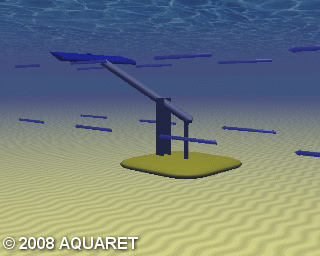
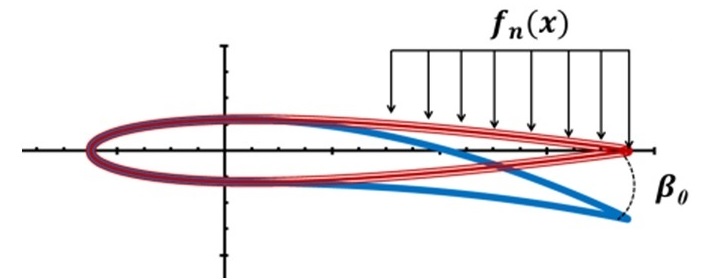
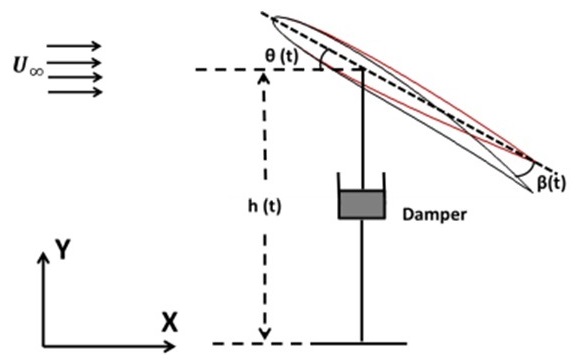
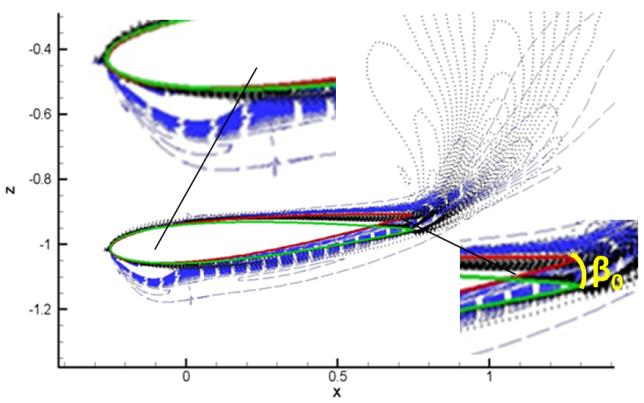
A Bio-Inspired Study on Tidal Energy Extraction with Flexible Flapping Wings
By Wendi Liu, Professor Qing Xiao and Supported by Lloyd’s Register Group Limited
Previous research on the flexible structure of flapping wings has shown an improved propulsion performance in comparison to rigid wings. However, not much is known about this function in terms of power efficiency modification for flapping wing energy devices. In order to study the role of the flexible wing deformation in the hydrodynamics of flapping wing energy devices, we computationally model the two-dimensional flexible single and twin flapping wings in operation under the energy extraction conditions with a large Reynolds number of 106. The flexible motion for the present study is pre-determined based on a priori structural result which is different from a passive flexibility solution. Four different models are investigated with additional potential local distortions near the leading and trailing edges. Our simulation results show that the flexible structure of a wing is beneficial to enhance power efficiency by increasing the peaks of lift force over a flapping cycle, and tuning the phase shift between force and velocity to a favourable trend. Moreover, the impact of wing flexibility on efficiency is more profound at a low nominal effective angle of attack (AoA). At a typical flapping frequency f*=0.15 and nominal effective AoA of 10 degrees, a flexible integrated wing generates 7.68% higher efficiency than a rigid wing. An even higher increase, around six times that of a rigid wing, is achievable if the nominal effective AoA is reduced to zero degrees at feathering condition. This is very attractive for a semi-actuated flapping energy system, where energy input is needed to activate the pitching motion. The results from our dual-wing study found that a parallel twin-wing device can produce more power compared to a single wing due to the strong flow interaction between the two wings.
We have performed a turbulent CFD simulation of an ocean tidal energy extraction device consisting of an oscillating/flapping flexible single and twin wing. The concept is inspired by the flexible wings of natural flying insects/birds and swimming fish. Particularly, the LEC, TEC and a further developed integrated model combining the best features of the above two models.
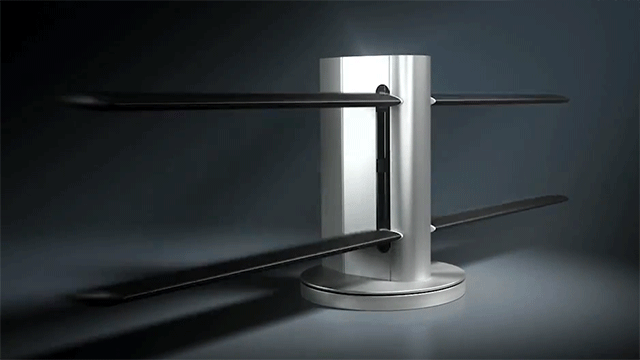


Flow Control for VATT by Fixed and Oscillating Flap
By Wendi Liu, Professor Qing Xiao
This research is aimed to explore the potential to improve Vertical Axis Tidal Turbine (VATT) energy harnessing efficiency by using modified blades with fixed and oscillating flap. The fixed flap concept is borrowed from its application in aerodynamics area for reaching a high lift force at low flying speed. Oscillating flap is motivated by our relevant biomimetic studies on the flapping wing propulsion or energy extraction. Present investigation is concentrated on a VATT with NACA 0018 profile blade as its baseline turbine. Numerical simulations are carried out by solving incompressible Unsteady Navier-Stokes equations at turbulence flow condition. Computed results show that under certain optimal flap geometry and flow conditions, turbine power coefficient reaches 28% enhancement as compared to the conventional blade turbine. Detailed analysis on the flow structure demonstrates that this is related to the effective flow separation suppression and vortex control by applying a fixed and oscillating flap.
In this study, a new concept via the use of a fixed and oscillating flap to moderate the traditional H-shaped VATT blade is proposed. By a systematic numerical modeling investigation, the potential benefit to improve the VATT energy extraction efficiency is explored. Simulation results indicate that the fixed and oscillating flap techniques indeed enhance the VATT performance significantly, especially at large tip speed ratio, where the boundary layer separation dominates the flow. In addition, it is found that an oscillating flap presents a better performance than that of a fixed flap. The parametric study performed provides the optimal geometry parameters under the real operating conditions. For a fixed flap blade, these include a slot angle of 60°, slot width of 0.03c, slot location at 0.7c. With an oscillating flap, additional parameters include the oscillating amplitude of 15° and the revolution ratio of 1.5. With the above parameters, the peak power coefficient (Cp) rises about 28% relative to the full blade turbine and the thread shed of tip speed ratio at which the Cp exhibits decaying trend increases about 43% as well. Examination on the flow details around the rotating blade indicates that the dynamic stall associated with turbine blade at large AOA is effectively delayed with the use of fixed blade. With an oscillating flap, it provides one additional influence on reducing the blade wake vortex interaction. Both of the above two factors are beneficial in order to increase the blade lift coefficient, momentum coefficient and thus the overall efficiency of turbine.
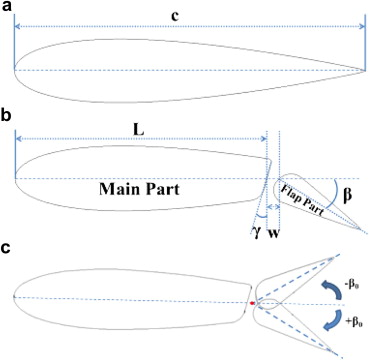
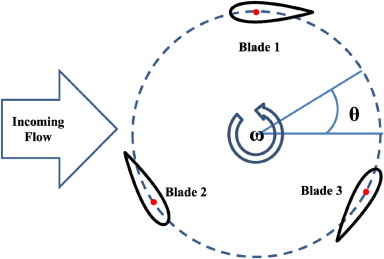
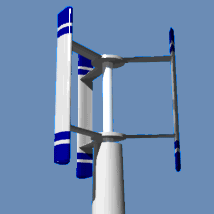
A Study of Fluid-Structure Interaction Problems for Floating Offshore Wind Turbines
By Yuanchuan Liu, Professor Qing Xiao
As one of the most abundant renewable energy sources in the world, wind energy has long aroused our interest. Along with the development of technology, wind turbines have been widely used all over the world to help extract energy from the restless wind. All of the wind turbines which have been deployed commercially are fixed and installed either on land or in shallow water near the coast. However, there are always objections about the visual impacts brought about by the installation. As a result, in recent years, people are assessing the feasibility of installing wind turbines far offshore so as to avoid those concerns. Furthermore, wind is more enduring and has better quality in deep water areas. All of these lead to the increasing interest in floating offshore wind turbines.
This project aims at the development of a coupled model of hydrodynamics and aerodynamics in time domain for floating offshore wind turbines under the framework of the popular open source CFD toolbox OpenFOAM. Our work starts with an existing incompressible two-phase CFD solver which is developed on OpenFOAM. The solver is already able to deal with hydrodynamic problems for floating platforms with mooring system. So what we need to do is to develop new functionalities to combine the hydrodynamic module with and the aerodynamic analysis module in OpenFOAM.
As a first step, the effects of the upper turbine part are simplified as aerodynamic force and moment which may be either constant or time-dependent. In the constant aerodynamic force model, the force is assumed to be determined by the incoming wind speed. In other words, when the wind speed is specified, the aerodynamic force can be obtained beforehand using the Thrust-Wind Speed curve shown in Figure 1. In the time-dependent model, the motion response of the platform is taken into account. The aforementioned curve is still used but here the force is actually defined by the relative velocity between the incoming wind speed and the instantaneous velocity of the platform. To achieve it, a look-up table is read at the beginning from which the force is interpolated at every time step. By doing so, the force is no longer a constant value but varies with time.
Figure 2 and Figure 3 show the surge response using different aerodynamic force models. From these figures, the influence of the aerodynamic force can be easily identified and difference between the two models is also shown, which demonstrate the importance and necessity of considering the aerodynamics of the upper wind turbine part.
In our second step, the effects of the supporting platform motion on the aerodynamics of a floating wind turbine are studied. The platform motion responses, including surge, heave and pitch, are superimposed onto the rotation of the wind turbine. Thrust and torque on the wind turbine are compared and analysed for the cases of different platform motion patterns together with the flow field. It is shown that the movement of the supporting platform can have large influences on a floating offshore wind turbine and thus needs to be considered carefully during the design process. For detailed information about this part of the research, please refer to the reference paper listed below.
In our third step, a full hydro-aero-mooring analysis is made possible by employing the solidBodyMotionFunction library in OpenFOAM, where the whole computational domain is decomposed to three adjacent domains connected by AMI patches (the OpenFOAM equavilent of sliding mesh patches). In this way, mesh deformation is avoided, which also decreases the computational cost. The following video shows the the 3DoF responses (including surge, heave and pitch) of the OC4-DeepCWind Semi-submersible floating wind turbine subject to both wind and wave loadings. A mooring system consisting of three catenary mooring lines is also employed to maintain the position of the FOWT.
Next, we want to take into consideration the aeroelastic effects for large offshore wind turbines by means of Multi-body Dyanmics. An open source software package for multi-body dynamics problems will be coupled with OpenFOAM to achieve a fully coupled Fluid-Structure Interaction simulation.
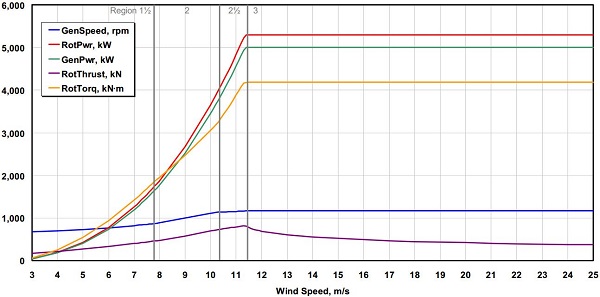
Figure 1 Relationship between thrust of turbine and wind speed (excerpted from: Jonkman JM (2007). Dynamics modeling and loads analysis of an offshore floating wind turbine. Doctoral dissertation, University of Colorado at Boulder, Boulder, Colorado.)
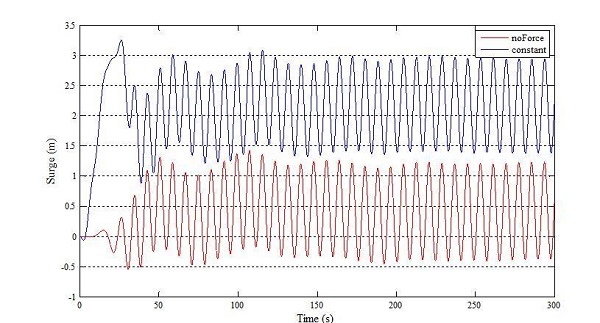
Figure 2 Comparison of surge response between cases with and without constant aerodynamic force
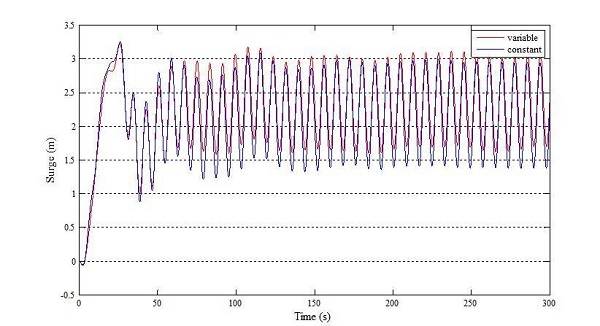
Figure 3 Comparison of surge response between cases with constant and variable aerodynamic force
Numerical Wave Tank Construction Using Source Term
By Saishuai Dai, Professor Qing Xiao
Numerical wave flume is now being paid more and more attentions with the rise of wave energy since simulation of wave is the most primary task of studying a wave energy converter by numerical methods. Generally, they can be divided into two types. First, physics mechanism methods such as piston, paddle wave makers Second, pure numerical methods: adding mass source term or momentum source term into governing equations. The second type of wave generating methods stand out for their significant advantages comparing with the first type: first of all, unlike the first type of methods, adding source term into governing equation methods does not require movement of generator which means it will not have the disadvantage of using dynamic mesh. This can avoid error caused by mesh motion and simplified calculation procedure. In addition, pure numerical methods can generate continuous incident wave while not being affected by reflected waves from obstructers. In our study, numerical wave tank is constructed using commercial CFD software FLUENT using VOF method. Key equations are given below:
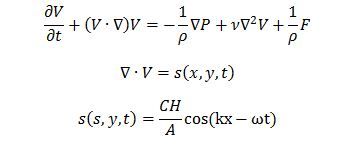
where s is the source function, C is the phase velocity, H is wave height, k is wave number and ω is the wave frequency. Results showed that our method can simulate linear wave successfully. Figure 1 showed the wave profile when t=50s. Figure 2 compared the time history of wave elevation at x equals one wave length from the beginning of the wave tank and the analytical result. As can be seen, the numerical results agreed with the theory very well.

Figure 1 Wave profile when t=50s

Figure 2 Comparison between numerical and analytical results
